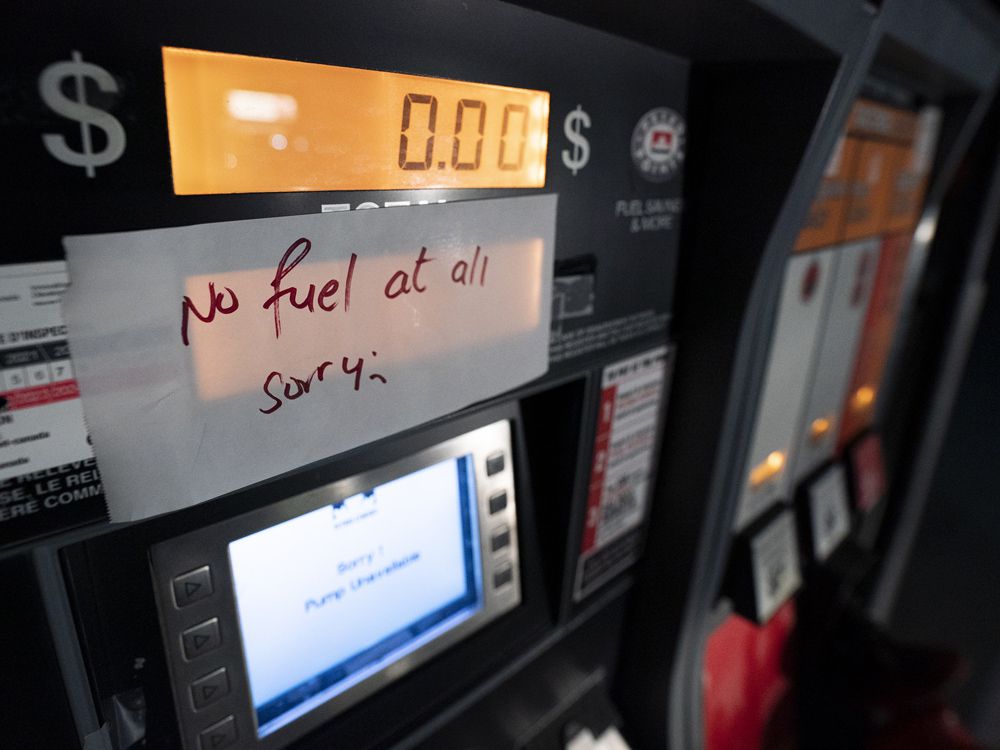Article content
VICTORIA — British Columbia has extended fuel rationing until Dec. 14 when the Trans Mountain pipeline is back online after a series of devastating storms in the southern part of the province.


Drivers have been asked to continue limiting their purchase of fuel to 30 litres per visit to a gas station

VICTORIA — British Columbia has extended fuel rationing until Dec. 14 when the Trans Mountain pipeline is back online after a series of devastating storms in the southern part of the province.
This advertisement has not loaded yet, but your article continues below.
Public Safety Minister Mike Farnworth says the province has also extended the state of emergency until the same date in order to ensure emergency services have the resources they need.
The pipeline has been shut down since Nov. 14, when a storm known as an atmospheric river hammered parts of southern B.C., flooding communities, farmland and washing away roads and bridges.
Energy Minister Bruce Ralston says the pipeline provides most of the fuel for B.C.’s Lower Mainland and Vancouver Island, which is now being shipped in by rail from Alberta and on barges from the United States.
Drivers have been asked to continue limiting their purchase of fuel to 30 litres per visit to a gas station.
A third storm in the last few days was forecast to move into B.C. late Monday and Tuesday.
This advertisement has not loaded yet, but your article continues below.
Farnworth said in a statement that while progress has been made on the province’s recovery, “we’re still in a volatile situation.”
Fuel conservation efforts have been working and ensuring there is enough fuel for emergency vehicles and commercial traffic, he told a news conference.
“We need to stay the course for another two weeks until we have the Trans Mountain pipeline back online,” he said.
Ralston said Trans Mountain is making sure the pipeline is safe to operate before it starts up again, but it will be at reduced pressure.
Restrictions on non-essential travel affecting stretches of highways 3, 7 and 99 remain in place, and Transportation Minister Rob Fleming urged drivers to stay off highways during the storms.
This advertisement has not loaded yet, but your article continues below.
“Extending the provincial declaration and fuel limitations will help us with the challenges ahead as we continue repairs to our heavily damaged highways and get our rail and roadways back up and in operation,” he said in a statement. “Having goods move along B.C.’s corridors is vital to moving goods and services to people in need.”
Environment Canada was warning that up to 200 millimetres of rain could drench the central coast of British Columbia and parts of Vancouver Island through to Wednesday. It says heavy downpours could cause water pooling on roads and flooding in low-lying areas, with snowmelt possibly adding to increased runoff with mild temperatures at higher altitudes.
Inland sections of the coast including Bella Bella were expected to get up to 120 millimetres of rain starting Monday evening, and motorists were told to avoid driving through water on roads.
This advertisement has not loaded yet, but your article continues below.
“Even shallow, fast-moving water across a road can sweep a vehicle or a person away,” the agency says in a written statement. “Be prepared for winter conditions at higher elevations.”
Between 50 and 100 millimetres of rain was expected for Metro Vancouver, the Fraser Valley, Howe Sound, Whistler and the Sunshine Coast.
The weather office said more than 100 millimetres of rain drenched the Fraser Valley city of Abbotsford over the weekend, while more fell in Hope.



Flood warnings have been issued for the Coldwater, Coquihalla, Nicola and Tulameen rivers, which all caused serious flood damage earlier this month to cities and towns along their banks, including Merritt, Spences Bridge, Princeton and Hope.
This advertisement has not loaded yet, but your article continues below.
A flood warning also remained in effect for the Sumas River through Abbotsford, where rising levels forced crews to set up a portable dam Sunday night to protect a key stretch of Highway 1.
Abbotsford Mayor Henry Braun said the focus was on flooding of the Nooksack River in Washington state because its high waters have the potential to further inundate low-lying areas.
A social media post by the City of Sumas in Washington says floodwaters from the river continued to move north toward Canada but had not yet reached a key bridge about 500 metres from the border.
A precautionary evacuation order was issued for some Abbotsford properties late Sunday. Several more homes were also placed on evacuation alert after a mudslide threatened properties on a hillside north of Highway 1, away from the Sumas River flooding.
This advertisement has not loaded yet, but your article continues below.
24World Media does not take any responsibility of the information you see on this page. The content this page contains is from independent third-party content provider. If you have any concerns regarding the content, please free to write us here: contact@24worldmedia.com

A Brief Look at the History of Telematics and Vehicles

Tips for Helping Your Students Learn More Efficiently

How To Diagnose Common Diesel Engine Problems Like a Pro

4 Common Myths About Wildland Firefighting Debunked

Is It Possible To Modernize Off-Grid Living?

4 Advantages of Owning Your Own Dump Truck

5 Characteristics of Truth and Consequences in NM

How To Make Your Wedding More Accessible

Ensure Large-Format Printing Success With These Tips

4 Reasons To Consider an Artificial Lawn

The Importance of Industrial Bearings in Manufacturing

5 Tips for Getting Your First Product Out the Door